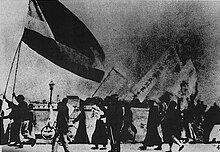May Fourth Movement

The May 4th Movement ( Chinese 五四 運動 / 五四 运动 , Pinyin Wǔsì Yùndòng ) found its origin in the student protests against the Treaty of Versailles on May 4th 1919. China sided with the Allies during World War I and hoped for the repeal of the Unequal treaties and non-recognition of the Twenty-One Demands of Japan of 1915. These hopes were not fulfilled by the treaties.
It united the intellectual, literary and political currents of the Movement for a New Culture between 1915 and 1925 with popular protest and thus gave it a broader base. The May Fourth Movement is considered to be the first mass political movement in Chinese history and thus serves many political currents as a reference point for identification and legitimation to this day.
Consequences of the Versailles Treaty
China entered World War I on the Allied side in August 1917, hoping to induce the Allies to repeal the Unequal Treaties and disregard Japan's Twenty-One Demands of 1915. Among other things, Japan had laid claim to the German branches in Shandong Province ( Kiautschou ), which it had conquered in 1914. The signing of the Twenty-One Demands by the Chinese government created a great deal of dissatisfaction and disappointment among many Chinese, and aroused strong nationalist and anti-Japanese sentiments, particularly among intellectuals.
During the negotiation of the Versailles Peace Treaty at the Paris Peace Conference in 1919 , the intention of the main victorious powers Great Britain and France to hand over Kiautschou to Japan became clear. They had secret agreements with Japan during the war that included that they would support Japanese claims in China if Japan remained on the side of the Allies in return. In addition, neither France nor the United Kingdom were willing to give up their extraterritorial privileges and leases in China.
The movement had the success that, in addition to the USA, the Republic of China did not sign the Versailles Treaty and instead concluded a separate peace treaty with Germany in May 1921. As a result, especially after the unification of China under the nationalist Kuomintang, there was increased cooperation between Germany and China .
Influence of the New Culture Movement
The New Culture Movement that began in the Young Republic of China brought together many intellectuals in China to work together for the future of the country. The aim of the movement was to question the old Confucian social order and to introduce western values in China, such as democracy, equality and freedom, as far as this seemed opportune for Chinese conditions. A new style was also introduced into Chinese writing and literature; the latest developments in science and technology were received and, if possible, adopted. The most famous leaders of the movement were Chen Duxiu , Cai Yuanpei and Hu Shi . Her ideas influence many Chinese students who turned against Japanese aggression. Numerous new think tanks and debating circles were founded in which the situation in China and possible solutions and models for current problems were discussed. One of these think tanks was the Young China Association founded in 1919 .
On May 4, 1919, more than three thousand students from various universities gathered in Beijing to demonstrate against Japan. Many people, including workers and traders, did the same as the students and organized demonstrations, strikes and boycotts of Japanese goods in Beijing and other cities. The movement had support in all classes of Chinese society. Numerous demonstrators were arrested.
However, under public pressure, the government had to release the arrested students. The unpopular foreign minister was dismissed. On June 28, 1919, the Chinese delegates refused to sign the peace treaty because it ignored China's wishes.
Influence on intellectual thinking
The May 4th Movement marks the beginning of mass political movements in China. It was the first time in Chinese history that people from different classes expressed their wishes together. A key person who developed these thoughts was the writer Zhou Zuoren .
The May 4th Movement was also a turning point in intellectual thinking that was becoming radicalized. Before that, the liberal democracy of the West had set a great example. However, the Treaty of Versailles was viewed as a fraud. Chinese intellectuals began to study Marxism / Leninism and became interested in the emerging Soviet Union as a possible socio-political model. Intellectuals such as B. Chen Duxiu and Li Dazhao dealt with the ideas of communism . The Chinese national conservatives were partly based on authoritarian or fascist models. The rise of the two radical parties, the Communist Party of China and the Nationalist Party of China (Kuomintang), and the later conflict between these two parties that ultimately led to civil war and the partition of China can be traced back to the events of the 4th Movement. May trace back.
literature
- Rana Mitter: A Bitter Revolution. China's Struggle with the Modern World. Oxford University Press, Oxford et al. 2004, ISBN 0-19-280605-X .
- Jonathan D. Spence: The Gate of Heavenly Peace. The Chinese and their Revolution, 1895-1980. Faber and Faber, London et al. 1982, ISBN 0-571-11868-2 .
